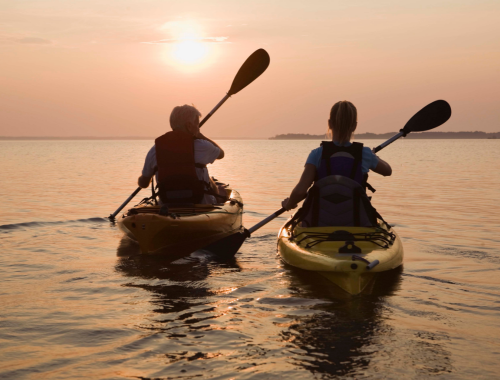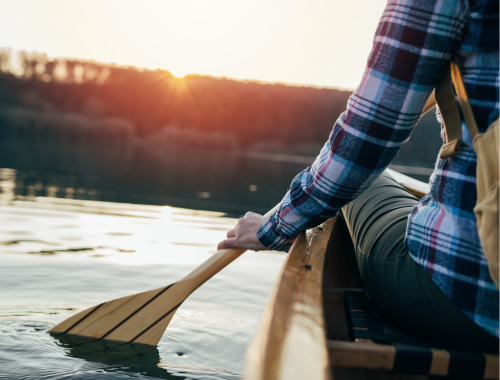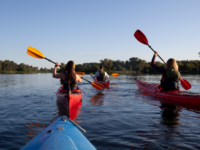Are you looking for some fun activities that involve water? Kayaking and canoeing are two fun and amazing ways to connect with nature and do some adventure on the water. Wherever you live, you are not very far from a water body, whether it’s a river, a lake, or even the ocean. Kayaking and canoeing open up a new, exciting world along the water’s edge. But what is a kayak? And what is a canoe? In this article, we will answer all your questions and point out some similarities between kayaks and canoes. Read on to know more!

Kayak
A kayak is a small, narrow boat with a cockpit where a person sits inside the hull, often with his legs extended forward. It is a rugged, off-road watercraft of the boating world and is shallower than canoes. Kayaks have a closed deck meaning the person paddling the boat is completely enclosed in the boat. They have less cargo capacity and are typically made of a light frame or from shells of fiberglass or plastic. Kayaks use a double-bladed paddle for propulsion. Fundamentally, there are two types of kayaks: river kayaks and touring kayaks. River kayaks are designed to turn while touring kayaks can go straight. Most kayaks are designed to be used by a single person.

Canoe
A canoe is typically wider and flatter than a kayak and has an open deck, which means the person is exposed to the elements. Unlike kayaks, a canoe can accommodate one more paddler and can carry lots of gear. Canoes sit high on the water and provide good visibility. They are more stable and easier to get into and out of than kayaks. The paddle is shorter, with a blade at just one end. There is more room for gear. They are easy to paddle solo and can generally go faster. In short, canoes are small, man-driven watercraft pointed at both ends and with an open design, where paddlers sit on benches or kneel inside.
Similarities between Kayak and Canoe
Similar Design
– Kayaks and canoes are both narrow, shallow boats that you can propel with a paddle. The idea is to push water backward to move the boat forward. You use your upper body strength and torso rotation to execute strokes. The paddling technique may vary slightly between the two vessels, but the fundamental principle remains the same. Kayaks, however, are typically narrower and more streamlined than canoes, making them more maneuverable.
Human-Powered
– Canoes and kayaks allow you (paddlers) to go where cars, motorboats, and bicycles cannot. They are human-powered watercraft that can silently slip along the banks of rivers, lakes, and oceans. They can easily maneuver up small streams and creeks that large boats cannot access. They do not have any motor or engine, which makes them suitable for recreational activities or exploration in natural settings. You don’t have to be in the wilderness to enjoy kayaking and canoeing.
Similar Construction Materials
– Traditionally, kayaks and canoes were both constructed using natural materials such as wood, bark, or animal skins. They were typically made of animal skins stretched over a wooden frame. However, modern versions of these watercraft are primarily made from a variety of materials like fiberglass, plastic, Kevlar, or aluminum. Today, rotomolded polyethylene is a common material used to make canoes and kayaks.
Versatility
– Both kayaks and canoes are very versatile; they can be used for an all-day outing or a week of camping. They are quiet which gives you the chance to see wildlife up close and undisturbed. Both watercraft are suitable for a wide range of activities, from leisurely paddling to recreational outings, fishing trips, sea kayaking, white water rafting, and whatnot. They can cater to various skill levels, from beginners to experienced paddlers.
Summary
Well, kayaks and canoes are both small, narrow watercraft specifically designed for paddling, with kayaks featuring a closed deck and canoes having an open design. They are similar in many ways and offer a great way to enjoy and explore waterways. They are suitable for every level of ability and for people with any combination of abilities. You can sail or paddle. You can sit, kneel, or stand. Kayaks and canoes are people’s yachts and are fun to ride.
FAQs
What is difference between a kayak and a canoe?
Kayaks are typically slim, closed-deck boats with a cockpit where the paddler sits inside the hull, often with their legs extended forward. Canoes, on the other hand, are typically wider and flatter and can accommodate one or more paddlers seated on benches or kneeling, using a single-bladed paddle.
Is a Canadian canoe a kayak?
A Canadian canoe is open from end to end and has a single blade, so it is not a kayak. A Canadian canoe has an open design where paddlers sit on benches or kneel inside the boat and use a single-bladed paddle. A kayak, however, is a slim, closed-deck boat with a cockpit. The paddler sits inside the hull and uses a double-bladed paddle for propulsion.
What is to go canoeing or kayaking?
To go canoeing or kayaking means to participate in the activity of paddling a canoe or kayak on a water body, such as a river, lake, or ocean. It involves using a paddle to propel the watercraft forward, navigate through the water, and enjoy recreational or outdoor experiences.
Is canoeing a Canadian thing?
Canoeing does hold particular significance in Canadian history and culture. Indigenous peoples in Canada and early explorers used canoes extensively for transportation and trade. Canoeing is still popular in Canada. There are many canoe clubs and organizations across the country.
What is the difference between a Canadian canoe and a kayak?
A Canadian canoe is an open watercraft with an open design that can carry multiple paddlers. A kayak, on the other hand, is a slim, closed-deck boat with a cockpit where the paddler sits inside the hull. It is designed for a single paddler but can also have tandem kayaks for two people.
Is kayaking hard for beginners?
Kayaking can be a bit challenging for beginners, especially if they are not accustomed to using a double-bladed paddle and have little experience with watercraft. However, with proper instruction, practice, and safety precautions, they can quickly learn the basic paddling techniques and enjoy kayaking.










Leave a Reply